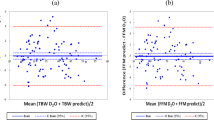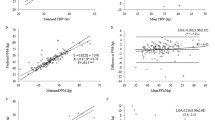Summary
The purpose of this investigation was to compare measured specific gravity values with predicted specific gravity values from skinfold measures using various prediction formulae.
Skinfold measurements were made of the unbilicus, triceps and chest of each of twenty-six young adult males. Specific gravities were predicted from the measurements using different formulae. Specific gravity was then determined for each subject by underwater weighing. Total body water was determined for each subject using the tritium dilution technique.
Predicted specific gravity values from the male triceps skinfold formula were not significantly different from actual specific gravity values. Predicted specific gravity from the male umbilicus skinfold measures and from the male chest skinfold formula were significantly different from actual specific gravity. Specific gravity was also predicted from a formula for females and all of these predicted specific gravity values were significantly different from actual specific gravity. Estimates of total body water revealed that body water content averaged 53 per cent of body weight and a range of 11 per cent. This variation is important and must be considered when small samples are used for measuring specific gravity by the water displacement technique.
Similar content being viewed by others
References
Behnke, A. R., Osserman, E. P., Welham, W. C.: Lean body mass. Arch. int. Mod.91, 585–601 (1953).
—: Physiologic studies pertaining to deep sea diving and aviation, especially in relation to the fat content and composition of the body. Harvey Lect.37, 198 (1941/42).
—, Welham, W. C.: The specific gravity of healthy men. J. Amer. med. Ass.118, 498–501 (1942).
Brozek, J., Keys, A.: Relative body weight, age and fatness. Geriatrics8, 70–75 (1953).
—, Brock, J. F., Fidanza, F. Keys, A.: Skinfold caliper estimation of body fat and nutritional status. Fed. Proc.13, 19 (1954).
—: Body composition. Ann. N. Y. Acad. Sci.110, 1–424 (1963).
Edwards, A. L.: Experimental Design in Psychological Research, Revised edition. New York: Holt-Rinehart and Winston 1964.
Fletcher, R. F.: The measurement of total body fat with skinfold calipers. Clin. Sci.22, 333–346 (1962).
Johnson, P. C.: Personal Correspondence, Baylor University College of Medicine, Radioisotope Laboratory, The Methodist Hospital, Houston, Texas, April, 1967.
Keys, A., Brozek, J.: Body fat in adult man. Physiol. Rev.33, 245–325 (1953).
Pascale, L. R., Grossman, M. I., Sloane, H. S., Frankel, T.: Correlations between thickness of skinfolds and body density in 88 soldiers. Hum. Biol.28, 165–176 (1956).
Rathbun, E. N., Pace, N.: Studies on body composition. The determination of total body fat by means of the body specific gravity. J. biol. Chem.158, 667–676 (1945).
Young, C. M., Martin, M. E. K., McCarthy, M. C. M., Manniello, M. J., Harmuth, E. H., Fryer, J. H.: Body composition of young women. J. Amer. diet. Ass.38, 332–340 (1961).
— —, Tensuan, R., Blondin, J.: Predicting specific gravity and body fatness in young women. J. Amer. diet. Ass.40, 102–107 (1962).
—, Tensuan, R. S.: Estimating the lean body mass of young women. J. Amer. diet. Ass.42, 46–51 (1963).
Author information
Authors and Affiliations
Additional information
This study was supported by Casner Research Laboratories, Inc. of Austin, Texas.
Rights and permissions
About this article
Cite this article
Early, R.G., Carlson, B.R. & Casner, S.W. Measured specific gravity, predicted specific gravity and total body water relationships in normal young men. Int. Z. Angew. Physiol. Einschl. Arbeitsphysiol. 28, 79–85 (1970). https://doi.org/10.1007/BF00698048
Received:
Issue Date:
DOI: https://doi.org/10.1007/BF00698048




